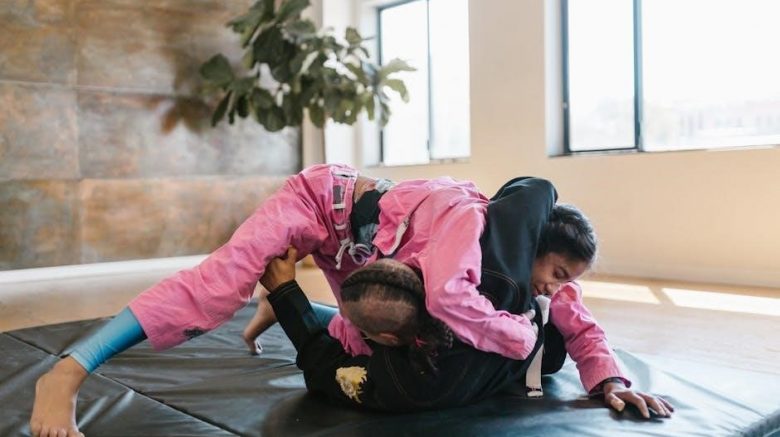Brazilian Jiu Jitsu Basics PDF: A Comprehensive Guide
Embark on a journey into Brazilian Jiu-Jitsu with this comprehensive PDF guide․ Discover the art of leverage, technique, and control․ This resource delves into the fundamentals, offering insights for mastering the mat and understanding its profound impact․ Learn about its historical roots and evolution․
Brazilian Jiu-Jitsu (BJJ) is a martial art centered on grappling and ground fighting․ Its effectiveness lies in using leverage and technique over brute strength․ BJJ teaches self-mastery through mat mastery․ It’s like chess with the body, demanding strategy and precision․
Originating from Judo and Japanese Jiu-Jitsu, BJJ has unique fundamentals․ It’s a martial art where understanding physics and body levers is key․ BJJ has gained global popularity for its unique martial arts technique․
BJJ is divided into self-defense, including strikes, and unarmed combat․ The goal is to submit your opponent․ While mastering every submission isn’t essential, knowing a few attacks is vital․
BJJ’s theory emphasizes natural movement, allowing practitioners to evolve․ Strong fundamentals are more effective than competition techniques for self-defense․ This overview covers the technical aspect, about 50% of rank determination․
BJJ has greatly influenced mixed martial arts (MMA), showcasing its effectiveness․ It addresses the fundamental problem of martial arts training through practice․
The Core Principles of BJJ: Leverage and Technique
At the heart of Brazilian Jiu-Jitsu lie two fundamental principles: leverage and technique․ BJJ emphasizes using these principles to overcome a larger, stronger opponent․ It’s not about brute strength; it’s about intelligent application of force․
Leverage allows a smaller person to amplify their strength․ By understanding angles and fulcrums, a BJJ practitioner can control and manipulate their opponent’s body․ This creates opportunities for submissions and positional dominance․
Technique is the practical application of leverage․ BJJ is a complex system of movements and strategies․ Each technique is designed to maximize leverage and minimize the practitioner’s exposure to danger․ It involves precise movements, body positioning, and understanding of biomechanics․
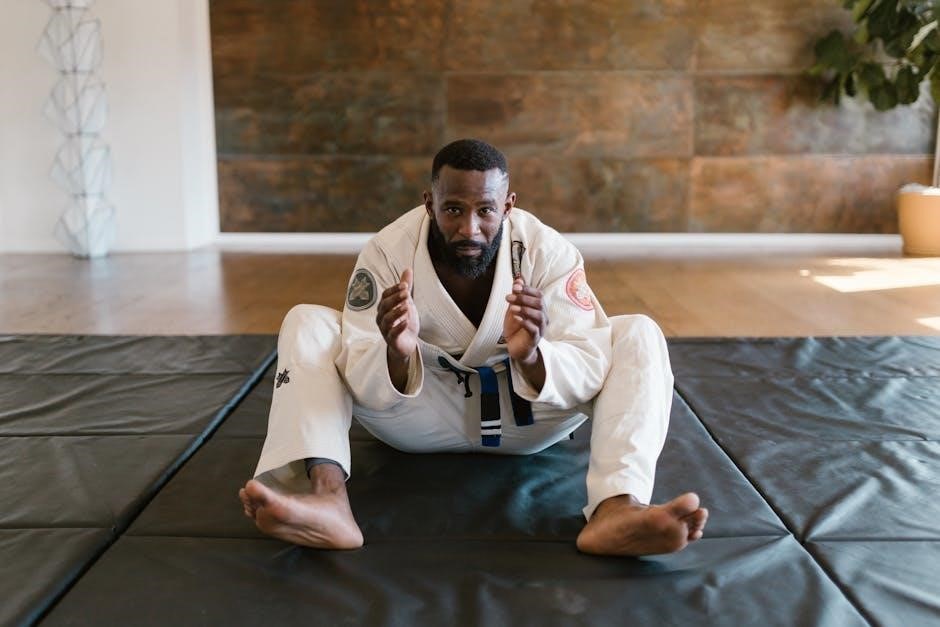
BJJ teaches practitioners to move naturally, creating a flowing and adaptive style․ These principles make BJJ effective for self-defense, competition, and overall fitness․ They underscore the art’s focus on intelligence and problem-solving in combat․
Mastering leverage and technique is crucial for success․ Through dedicated training, individuals can embody these core principles and maximize their potential in BJJ․
Fundamental BJJ Positions: An Overview
Understanding the basic positions in Brazilian Jiu-Jitsu is essential for any practitioner․ These positions form the foundation for all techniques and strategies within the art․ They dictate your control, defensive options, and potential for attacks․
Mount is a dominant position where one combatant sits on the opponent’s torso․ It offers significant control and opportunities for submissions․ Back Control involves securing the opponent’s back with hooks, providing excellent control and submission possibilities like chokes․
Guard is a complex position where you control the opponent using your legs․ There are several variations, each offering unique control and attack options․ Side Control involves pinning the opponent to the ground from their side, restricting their movement and creating submission opportunities․
Knee on Belly places your knee on the opponent’s abdomen, causing discomfort and limiting mobility․ Half Guard involves controlling one of the opponent’s legs between your legs, offering a mix of defensive and offensive opportunities․
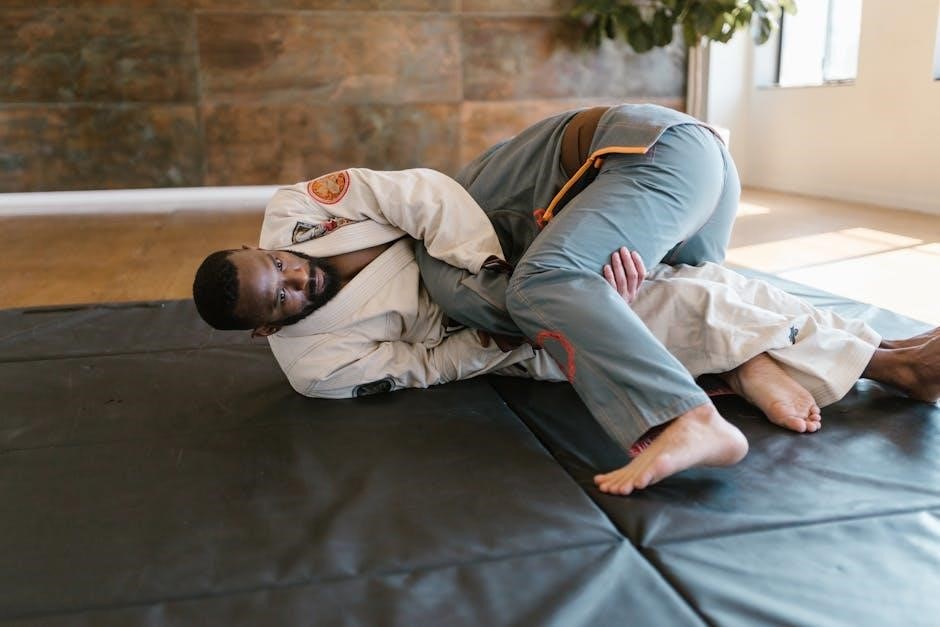
These positions are interconnected, and transitions between them are fundamental to BJJ․ Mastering these positions requires dedicated practice and understanding of leverage, control, and submission techniques․
Takedowns and Throws in BJJ Basics
Takedowns and throws are crucial components of Brazilian Jiu-Jitsu, enabling practitioners to bring the fight to the ground, where BJJ excels․ These techniques involve unbalancing and manipulating an opponent’s posture to force them to the mat, setting the stage for ground-based submissions and control․
A fundamental takedown is the double-leg takedown, where the practitioner shoots in, secures both of the opponent’s legs, and drives forward to bring them down․ Single-leg takedowns involve grabbing one leg and using leverage to disrupt the opponent’s balance․
Throws, often borrowed from Judo, such as the O-Goshi (hip throw) and Seoi-Nage (shoulder throw), utilize momentum and precise body positioning to lift and throw the opponent․ These throws require coordination and timing․

Effective takedowns and throws in BJJ involve more than just strength; they rely on understanding angles, leverage, and proper technique․ Drilling these techniques regularly is essential for developing the muscle memory and reflexes needed to execute them effectively in live sparring․

Mastering takedowns and throws provides a significant advantage in BJJ, allowing practitioners to dictate the pace and location of the fight․ They are also valuable for self-defense, enabling one to control an aggressor and bring the situation to the ground․
Guard Techniques: A Detailed Exploration
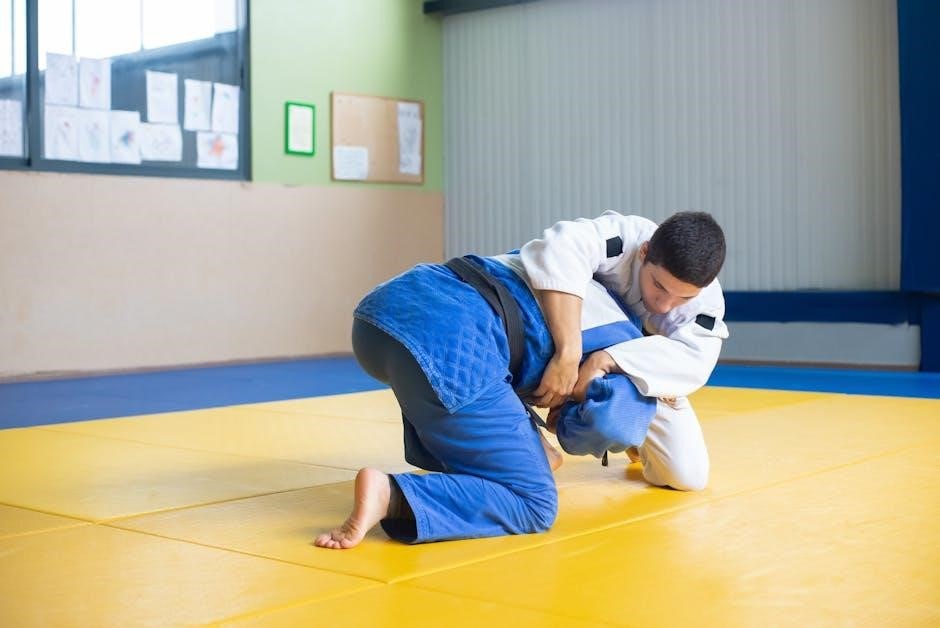
The guard is a fundamental position in Brazilian Jiu-Jitsu (BJJ), characterized by one fighter controlling the other from their back using their legs and arms․ It’s a defensive and offensive position, allowing the guard player to protect themselves while setting up sweeps and submissions․
There are several types of guards, each with distinct characteristics and strategies․ The closed guard involves tightly wrapping the legs around the opponent’s waist, limiting their movement and control․ The open guard encompasses various leg configurations, such as butterfly guard, spider guard, and De La Riva guard, each offering different angles and control points․
Butterfly guard utilizes the feet on the opponent’s inner thighs to control distance and create sweeping opportunities․ Spider guard involves using the hands to control the opponent’s sleeves while maintaining foot placement on their biceps, offering strong control and submission threats․
De La Riva guard is characterized by hooking one of the opponent’s legs with one leg while controlling their sleeve with the opposite hand, providing excellent sweeping and inverting options․
Mastering the guard involves developing strong grips, maintaining proper posture, and understanding the dynamics of each guard variation․ It’s a crucial skill for any BJJ practitioner, enabling them to control the fight from their back and launch effective attacks․
Escapes and Submissions from the Guard
The guard, a cornerstone of Brazilian Jiu-Jitsu, isn’t just about defense; it’s a launchpad for escapes and submissions․ Mastering this aspect of BJJ is crucial for both offensive and defensive prowess on the ground․ Escaping the guard involves neutralizing the opponent’s control and creating space to stand up or transition to a more advantageous position․
Basic guard escapes often involve creating angles, disrupting the opponent’s balance, and using leverage to break free․ For instance, escaping the closed guard might involve hip escapes, standing up in base, or transitioning to a butterfly guard to create space․ Effective escapes require timing, technique, and an understanding of the opponent’s intentions․
Simultaneously, the guard offers a plethora of submission opportunities․ Common submissions from the guard include armbars, triangles, and omoplatas․ These submissions capitalize on the opponent’s positioning and leverage, allowing the guard player to secure joint locks or chokes․
Armbars from the guard typically involve isolating an arm, controlling the opponent’s posture, and applying pressure to the elbow joint․ Triangle chokes utilize the legs to create a triangle around the opponent’s head and shoulder, cutting off blood flow to the brain․ Omoplatas involve using the legs to control an arm and shoulder, creating a shoulder lock․
Successfully executing submissions from the guard requires precise technique, control, and the ability to anticipate the opponent’s movements․ A well-rounded BJJ practitioner must be proficient in both escaping and submitting from the guard․
Basic Submissions: Armlocks, Chokes, and Leglocks
Submissions are the ultimate goal in Brazilian Jiu-Jitsu, representing the culmination of positional control and technical application․ Among the most fundamental submissions are armlocks, chokes, and leglocks․ Mastering these techniques is essential for any BJJ practitioner, regardless of their experience level․
Armlocks, such as the armbar and Americana, target the elbow joint, applying pressure until the opponent submits․ Armbars typically involve isolating an arm, controlling the opponent’s posture, and extending the arm to hyperextend the elbow․ The Americana, also known as the keylock, involves bending the arm behind the opponent’s back, applying pressure to the shoulder and elbow․
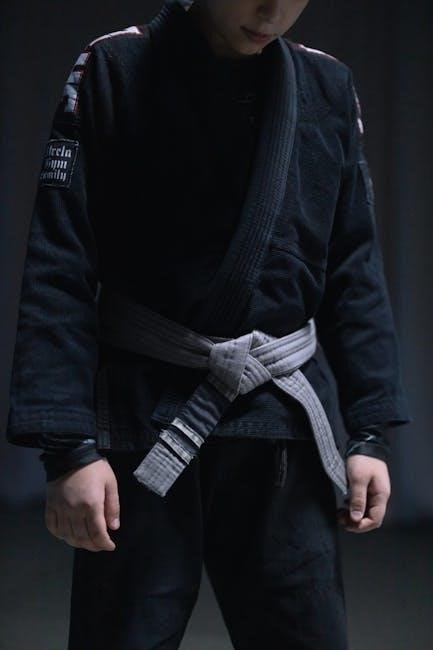
Chokes, including the rear-naked choke and triangle choke, restrict blood flow to the brain, causing the opponent to lose consciousness․ The rear-naked choke involves encircling the opponent’s neck with an arm, applying pressure to the carotid arteries․ The triangle choke uses the legs to create a triangle around the opponent’s head and shoulder, constricting blood flow․
Leglocks, such as the straight ankle lock and kneebar, target the ankle and knee joints, respectively․ The straight ankle lock involves hyperextending the ankle joint, while the kneebar applies pressure to the knee joint, potentially causing ligament damage․
Successfully executing these submissions requires precise technique, control, and an understanding of leverage․ It’s crucial to practice these techniques safely with a qualified instructor to avoid injury․
Positional Hierarchy and Control
In Brazilian Jiu-Jitsu, positional hierarchy dictates the relative advantage one grappler has over another․ Understanding this hierarchy is crucial for both offense and defense․ Dominant positions allow for greater control and submission opportunities, while inferior positions require strategic escapes and transitions․
Mount is often considered the most dominant position, offering superior control and numerous submission options․ Back control is another highly advantageous position, providing excellent control and choke opportunities․ Top position in guard allows for passing attempts and pressure, while side control offers a balance of control and submission possibilities․
Conversely, bottom positions like being mounted or having back control taken are considered inferior․ The guard, while offering some defensive capabilities, is generally considered a neutral or slightly inferior position compared to top control․ Half guard can be a defensive position, but also offers opportunities for sweeps and transitions․
Control is the ability to maintain a dominant position and prevent the opponent from escaping or improving their position․ Effective control involves proper body positioning, weight distribution, and grip fighting․ Maintaining control allows you to dictate the pace of the match and set up submission attempts․
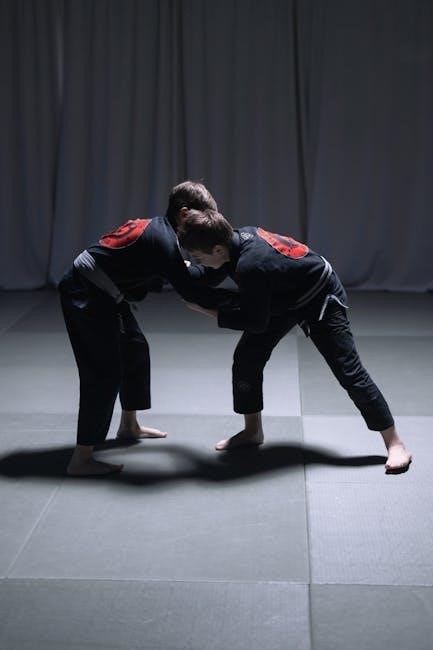
Mastering positional hierarchy and control is essential for success in BJJ․ By understanding which positions offer the greatest advantage and how to maintain control, you can significantly improve your grappling game․
BJJ for Self-Defense: Practical Applications
Brazilian Jiu-Jitsu offers a highly effective system for self-defense, particularly in close-quarters combat․ Its emphasis on grappling and ground fighting provides practical tools for neutralizing threats, especially in situations where striking may be limited or ineffective․ BJJ’s focus on leverage and technique allows a smaller, weaker individual to defend against a larger, stronger attacker․
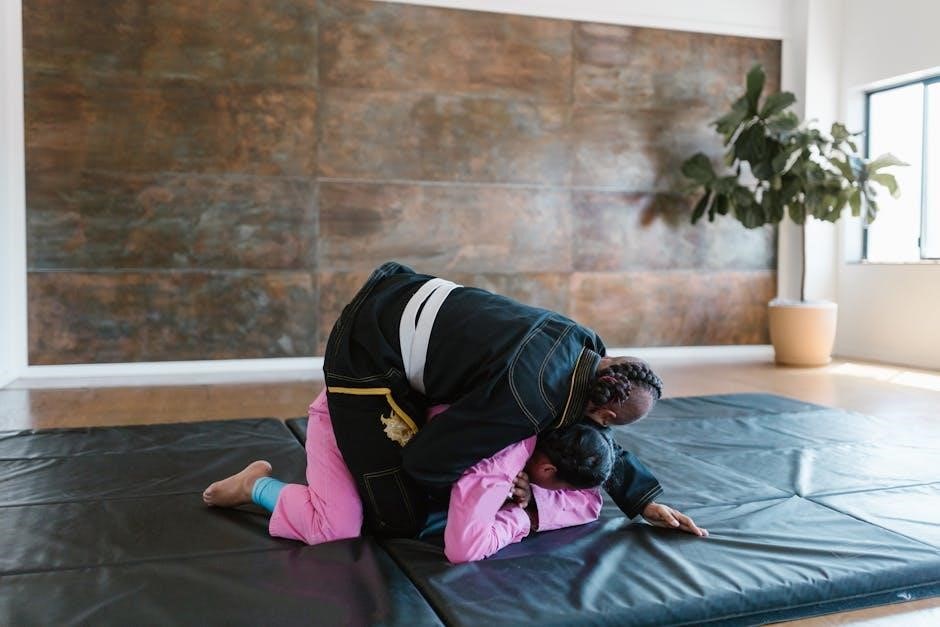
One of the primary self-defense applications of BJJ is its ability to control and subdue an opponent on the ground․ Takedowns and throws, modified for real-world scenarios, can be used to bring an attacker to the ground, where BJJ practitioners excel․ The guard position, in particular, provides a framework for defense and control from the bottom․
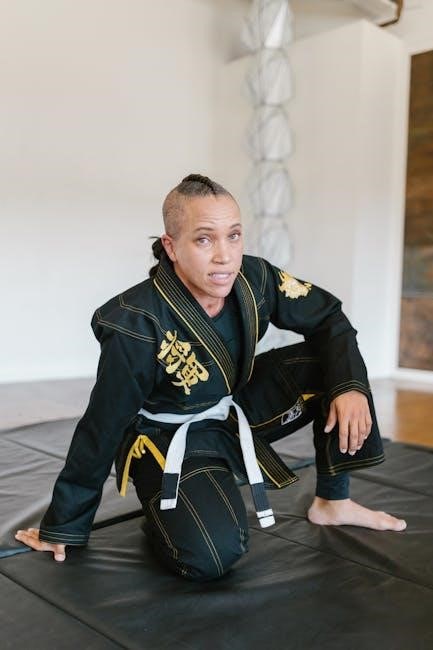
Escapes from various positions are crucial for self-defense, allowing you to create space and regain a more advantageous position․ Submissions, such as armlocks and chokes, can be used to incapacitate an attacker, providing an opportunity to escape or call for help․ Positional awareness and control are key to maintaining safety and dominance in a self-defense situation․
BJJ training also instills valuable skills such as situational awareness, conflict de-escalation, and the ability to remain calm under pressure․ These skills are essential for navigating potentially dangerous situations and making informed decisions․ While sport BJJ focuses on competition, adapting the techniques for self-defense scenarios is crucial for practical application․
Training Methodology and Progression in BJJ
Brazilian Jiu-Jitsu training follows a structured methodology designed to progressively develop skills and understanding․ Beginners typically start with fundamental techniques, focusing on basic positions, movements, and submissions․ Drilling these fundamentals repeatedly builds muscle memory and ensures a solid foundation․
Live sparring, or “rolling,” is a crucial component of BJJ training․ It allows students to apply techniques in a dynamic, resisting environment․ Sparring helps develop timing, reflexes, and the ability to adapt to different opponents and situations․ As students progress, they gradually incorporate more complex techniques and strategies into their game․
Progression in BJJ is typically marked by a belt ranking system, with each belt representing a certain level of skill and knowledge․ Promotion criteria vary, but generally include technical proficiency, consistent attendance, and a demonstrated understanding of BJJ principles․
Beyond technical skills, BJJ training also emphasizes mental fortitude and perseverance․ Overcoming challenges and setbacks is an integral part of the learning process․ Instructors play a vital role in guiding students, providing feedback, and fostering a supportive learning environment․ Regular training, combined with consistent self-assessment, is essential for continuous improvement in BJJ․
Specific training methodologies can include positional drilling, where students focus on specific scenarios, and flow rolling, which emphasizes smooth transitions and movement․ Strength and conditioning are also important aspects of BJJ training, as they enhance performance and reduce the risk of injury․
